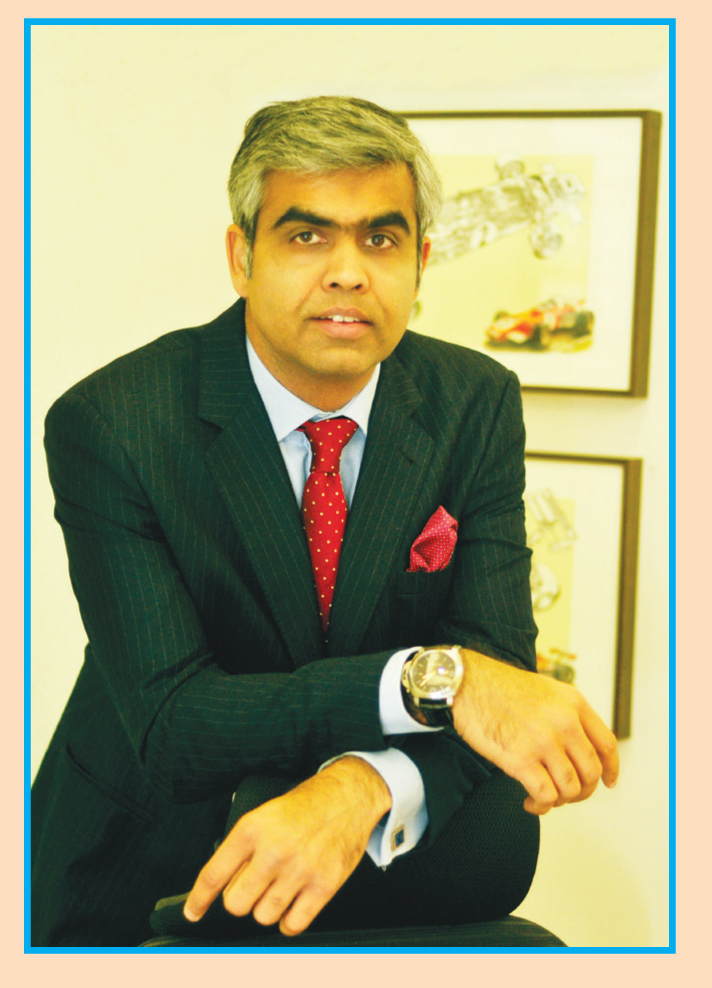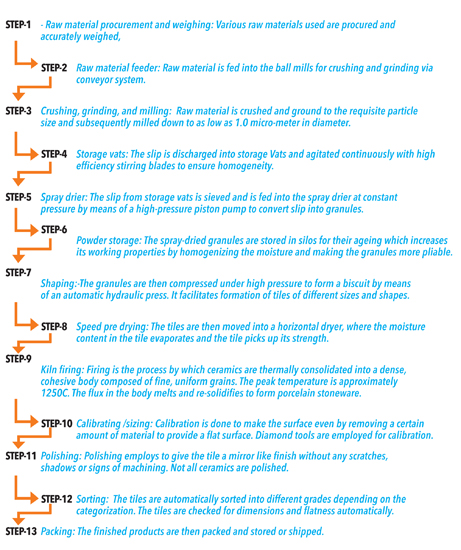A little bit of both, actually. Extensive interactions with companies (listed and unlisted), channel partners, architects, and industry observers indicate several changes on the horizon for the domestic tiles industry. The real questions are really about the extent and timing of these shifts, and not the probability of their occurrence.
1.Prices to soften / remain static in the near term
While a subtle increase in competitive intensity coupled with subdued growth in consumption (8-10%) could contribute to static prices across tiling products, the decline in manufacturing costs (Power & fuel) and the dip in logistics costs could result in a mark-down in prices across the industry. While all this is contingent on gas prices and transportation costs maintaining their current trajectory, channel checks point to such a scenario panning out over the next few quarters.
2.Frequency of product range expansion by unlisted players to rise
Most companies in the industry follow the norm of introducing 3-4 new designs of tiles every month. Dealers and architects point out that in order to step up their game and compete effectively against imports and larger, listed players, players from Gujarat are gradually stepping up the tempo of designs and SKU introductions. While this could not be individually verified from Gujarat-based unlisted players, it seems perfectly logical since this would contribute immensely towards brand development and customer acquisition.
3.Export focus to intensify
The imposition of punitive duties on Chinese tile exports in most global markets has opened up avenues for exports for Indian companies, either through white-label supplies or under their own brand. While markets in the neighbouring SAARC countries have always been targeted, manufacturers in Morbi are increasing their shipments to the Middle East and Europe. Using dynamic feedback, exporters from Morbi are stepping up customisation and broadening their range. This, coupled with competitive pricing, is enabling several unlisted Indian manufacturers on increasing their quantum of exports – a trend that should gather momentum in the near term.
1.Growth through the JV model to be pursued more aggressively
Several rounds of capacity expansions are envisaged over the next decade, as manufactures move to satisfy the volume and variety demand at home and overseas. However, capital efficiency and compartmentalisation of competencies could lead to companies collaborating with each other through JVs. These alliances could be for outsourcing production, sharing of specified output, marketing tie-ups, or a combination of all three in a hybrid form.
2.Shelf size to increase, but share to drop
With the entry of additional players into the branded tile segment, most dealers and distributors said that the range of products stocked at their end was definitely expanding. However,
competition and a wide variety of products would result in a change in the market share dynamics of older players, despite the market growing.
3.Smaller players may have to up their game or face stagnation
The gradual build up in competitive intensity in the domestic tile industry would necessitate innovation and operational flexibility in production, distribution, and financial control. Thus, companies with smaller scale may have to invest more bandwidth and material resources to be fleet-footed in order to survive and grow. “Traditional soch se hatna padega, nahi toh mushkil ho jayegi (it will be difficult unless the conventional thought process is modified),” responded Mr. Kundalia, when questioned about the future of small-scale manufacturers in Morbi.

Innovation has been the key to our success. Increased capacity utilisation and wider footprint have enabled us to stay ahead.
One could easily mistake the office of Mr. Abhishek Somany (JMD, Somany Ceramics) for a museum of miniature cars. An afficianado of all things automotive and racing, Mr. Somany took time out to patiently talk about the operations of Somany Ceramic, detailing with mechanical precision the transformation of the Indian tile market. Key takeaways of the chat:
Could you tell us about your company?
Somany Ceramics was founded in 1969 by Mr HL Somany in collaboration with Pilkington’s Tile Holding, UK. Today, we are one of the leading manufacturers and marketers of tiles, sanitary-ware, and bath fittings in India, and produce 60 mn sqm of vitrified and ceramic tiles from two fully-owned facilities (one in Kadi in Gujarat and one in Kassar, Haryana) and seven six joint-venture facilities at Morbi in Gujarat.
We have a pan-India presence with vast distribution network comprising of 10000-plus dealers and sub-dealers, and 180 franchisee-managed showrooms and owned display centres.
What are the market trends for 2016?
Greater utility, decorative qualities, easier maintenance are some of the reasons for tiles becoming popular over the last two decades. International
trends are the first ones to be adapted by consumers in India and as more and more Indians have started often visiting/living abroad, expectations have transformed completely.
Buyers today are looking beyond traditionally designed tiles and are moving towards specialised tiles for different usage areas. Maintenance-resistant, hygienic, yet stylish tiles are preferred for kitchen and bathrooms. Consumers pick up design options that reflect their lifestyle, but are cost effective as well. Taking the technologically driven route, 3D tiles add an additional aspect to space. These tiles have started picking up in the market and are expected to experience an upsurge in the coming year. The demand for ‘green’ tiles is also on the rise and is likely to increase. Tiles using leather, metal, and other non-traditional natural hues and surfaces are a popular choice these days, especially when used as decorative embellishments. Mosaic patterned tiles, to create a picture or a repeating design are now preferred over bland printed tiles.
Even the size of the tiles is expanding to suit the modern needs. It is a growing trend to prepare large continuous surfaces and minimize joints,allowing them to install with minimal grout lines. Somany produces tiles in various sizes – 600×1200, 800×1200, and 800x800mm.
What is the USP of your company?
Innovation is our USP. Somany has been investing its energies in product innovation and increasing capacities across segments, with more focus on the higher-margin segments. To cater to the dynamic sentiments of our consumers, we have a product basket of tiles (floor and wall), sanitary-
ware, and CP fittings.
What are your future plans?
We are focusing on doubling output in the next three years. New construction and renovation of existing properties will boost demand for ceramic tiles. Over the years, we have realised that the best way to grow is to outsource production to smaller players and leverage our brand and distribution network for marketing and selling. We shall continue with our asset-light model for growth, where we will keep adding to our capacity by taking stakes in the equity of smaller manufacturers, who will then produce exclusively for us.
We shall also expand the plants of our existing associates and continue to enhance our offerings through more value-added products. To be a one-stop destination for all home-decor needs, we will ramp-up our sanitary-ware and bathroom-fittings segments.
We will strengthen our retail footprint further by adding more franchisee-run stores year-on-year. In addition, tier-2 and tier-3 towns and exports would be thrust areas for enhancing sales. These strategies should result in sustainable top- and bottom-line growth. We will invest accordingly for expanding our business operations and upgrading
our manufacturing facilities. We are targeting +20% growth in FY16, as there is high growth potential in the ceramic tile industry.
We have no diversification plans for the time being, and will continue with the existing business verticals.
What strategies do you follow to handle competition from your organised and unorganised counterparts?
Every company has a different business strategy. We believe in ours. We offer multiple platforms to customers, so that we are in their reach radius. We have highly equipped centres with a wide range of tiles, sanitaryware, and bath fittings to offer. The number of stores, either dealer-operated or company-owned, across the country, enhances our brand visibility through improved accessibility for customers. Our website is also a major touch point, which is regularly updated.
For beating competition from the organied sector, we have been investing our energies in product innovation and increasing capacities across segments – with more focus on the higher-margin segments. To cater to the dynamic sentiments of the consumers, we offer a comprehensive bouquet of products, thus becoming a ‘One-Stop-Shop’ for customers.
Our strategy for beating competition from the unorganised sector is basically to increase our footprint in the country and increase our range to more and more tier-2 and 3 towns, as most of the construction activity is going on there. These markets have a huge potential, as more people are switching over to the use of tiles in their homes as well as in commercial areas.
Apart from this, we are also focusing a lot on branding – at the end of the day, it is the brand that sells as customers are aware that a good brand not only guarantees consistent quality but also offers a huge range.
What is the demand scenario like outside tier-1 cities?
With urbanisation spreading to tier-2 and 3 cities, there is healthy demand for tiles, sanitary-ware, and bathroom fittings. These cities are growing commercially, industrially, and have rising population and education opportunities. These markets have a huge potential; our distribution network covers almost all tier-2 and tier-3 cities in India.

Quantity is not the only factor today, Quality is equally important. Without quality, the consumer will not come back to a brand.
As an industry veteran of the Indian tile market, there are very few district headquarters in India that Mr. Tapan Jena hasn’t visited to sell his product. By virtue of more than two decades in the business, handling numerous functions ranging from sales, marketing, logistics etc he is CEO of SunHeart Ceramics. A cheerful disposition and keen sense of humour apart, his incisive observations about the tile industry formed the basis of this GV report. A selection of some of the choicest bits of conversation with him are enclosed below:
Today, players from Gujarat, and from Morbi in particular, have created an enviable reputation for themselves. Yet, the quality of their output is sometimes questioned. Your thoughts on this?
In the current tiles market, Morbi controls around 60% market share (in volumes) and every year around 40 to 50 new plants enter the market. All these plants start with good product quality and contemporary designs. However, sometimes, due to costing pressures, some companies compromise on quality and gradually lose their reputations.
Thankfully, the occurrences of such cases is reducing, as operations these days are handled by the new second-generation entrepreneurs who are educated and understand the importance of good quality.
How important is it to have a brand in the tile industry today? How do you see brands evolving over the next decade?
A brand plays a vital role in in this industry, but only if you can match quality expectations and produce sufficient quantities. If you look at the previous decade, there were fourteen brands operating in India, but today there are only six to seven. Several companies perished because they could not sustain the pressure of supply and quality.
There are ample opportunities for brands to grow, as most of them are buying/sourcing from Morbi as per their quality requirements. This enables them to be more competitive and affordable and simultaneously provide customers with a wide choice.
Additionally, the price gap between branded and non-branded has narrowed significantly over the past decade, mainly due to efficiencies in manufacturing and lower logistics costs. As a result, customers are opting for branded products.
This is a huge opportunity for players who are competent, but do not have a brand.
How do you see brand development evolving for the smaller and mid-sized tile manufacturers over the next few years?
The change is happening as we speak. Until recently, such spends were ~1-2% of net sales –in the form of distribution of free samples. However, several prominent unlisted companies have earmarked 3-4% of their sales in coming years for brand-building activities like trade exhibitions, radio jingles, appointing brand ambassadors etc.
In the light of the anti-dumping duty imposed on Chinese imports into India and in other countries, what is your outlook for the tile trade in the country?
Imports have picked up in the last one year and are available 15-20% cheaper, specifically in the polished vitrified segment. The imposition of anti-dumping duties in several European countries, Taiwan, and Brazil among others on imports from China may have prompted Chinese tile manufacturing companies to look at the Indian market in a big way.
The import of these tiles has been rampant in port towns such as Mumbai, Chennai, Kolkata, and Kochi. So far, the practice has been mainly concentrated in port cities, but it will soon spread and can reach out to the hinterland.
With the imposition of anti-dumping duties, the PVT segment will definitely grow, specifically in ports and surrounding areas. Meanwhile, Indian exports are growing at an extremely encouraging clip and should be able to sustain this tempo in the future.
What new concepts do you see evolving in the tile industry that would carry the industry forward?
The Indian consumer is very quick to adopt the latest trends. Consequently, manufacturers are also upgrading technology to keep pace with global trends. Five years ago, there were no digital-printing technology, but today there are more than 250 machines – a number that is growing.
Tiles are no longer only a flooring medium, but a style statement. New and exciting products, which are relevant, are quick to be accepted in the country. A good example of this is that larger-formatGV tiles and slim tiles are finding increasing acceptance in India.
Going forward, interesting innovations in terms of thickness, finish, design, and size will continue to drive growth for the industry, which I think will be in double-digits for the next decade.

Subscribe to enjoy uninterrupted access